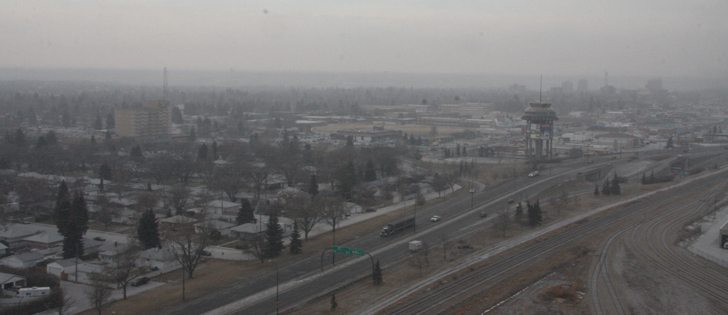Murphy’s Law prevailed. Just as I reached the pinnacle of the giant ATL-painted but Cargill-owned grain terminal in Lethbridge, a snow flurry came through. So much for scenic photos from the top of the tallest building in the city.
Like the majority of Producer readers, I’d been inside grain elevators before. Many times, in fact. But this 80-year old facility has long intrigued, especially when I look at the windows that always seem to be open near the top.
What’s up there? What’s the view? Who has to fix all those windows?
Read Also

Topsy-turvy precipitation this year challenges crop predictions
Rainfall can vary dramatically over a short distance. Precipitation maps can’t catch all the deviations, but they do provide a broad perspective.
Brad Ternes, general manager of the terminal, jokes that on a clear day, the annex men who work in the upper floors of the terminal can see what’s on the menu at Ric’s Grill, the restaurant inside the former water tower. On the day I was there, the water tower was blurry amid snow flurries and the mountains, which should be visible from that vantage, were a mere thought.
Nevertheless, Ternes provided a memorable tour of the place, which appears to have some of its original 1931 furniture — the solid wood desks and chairs of the era. It’s just too difficult to get it out of there, he said. And it appears to be serving a purpose, so what’s the point?
But more importantly, the terminal still utilizes much of the original equipment that builders installed with foresight into how grain handling might evolve.
That was one of the most intriguing things shared on the tour. The pits where trucks unload will hold an entire Super B’s worth of grain, even though those big haulers didn’t exist in 1931. The scales hold a hopper car’s worth of grain, even though much smaller boxcars were the norm in the ‘30s.
Historical photos show the terminal was far from town when it was built, but now it’s conveniently located along Highway 3, or Crowsnest Trail, as that road is called when it passes through the city.
In a booklet about the terminal, Lethbridge historian Irma Dogterom reports the total cost of construction was just under $950,000. That’s about $16 million in today’s dollars, if you do the conversion using the Bank of Canada’s inflation calculator. But I doubt a facility this size could be built for that amount today. The concrete alone might cost that much.
Dogterom quotes verbatim from the Oct. 15, 1931 issue of The Lethbridge Herald, in which a reporter documents a visit to the brand new terminal. He or she mentions the four large Fairbanks-Morse scales, each weighing 150,000 pounds.
They are still there.
The story mentions the electric elevator, “by means of which the visitors ascended to the roof, approximately 200 feet from the ground. From here a splendid view of the city can be gained.”
The elevator is still there. The view is there too, depending on the weather.
Says the Herald: “On the distributing floor are located three large conveyor belts on which the grain is moved to the bins on the west of the elevator. Each of these belts is approximately 750 feet in length. A tripper on each permits the grain to drop into whatever bin it is desired to fill.”
Yup, they’re still there and running fine. Wheat and canola were speeding their way through the system Dec. 18.
There’s more to say, in a coming issue of the paper. The tour was interesting as an observation of grain handling, but it also makes one think. Do today’s major structures involve the foresight employed by planners and builders of 1931?
The answer may require further tours. Sign me up.















